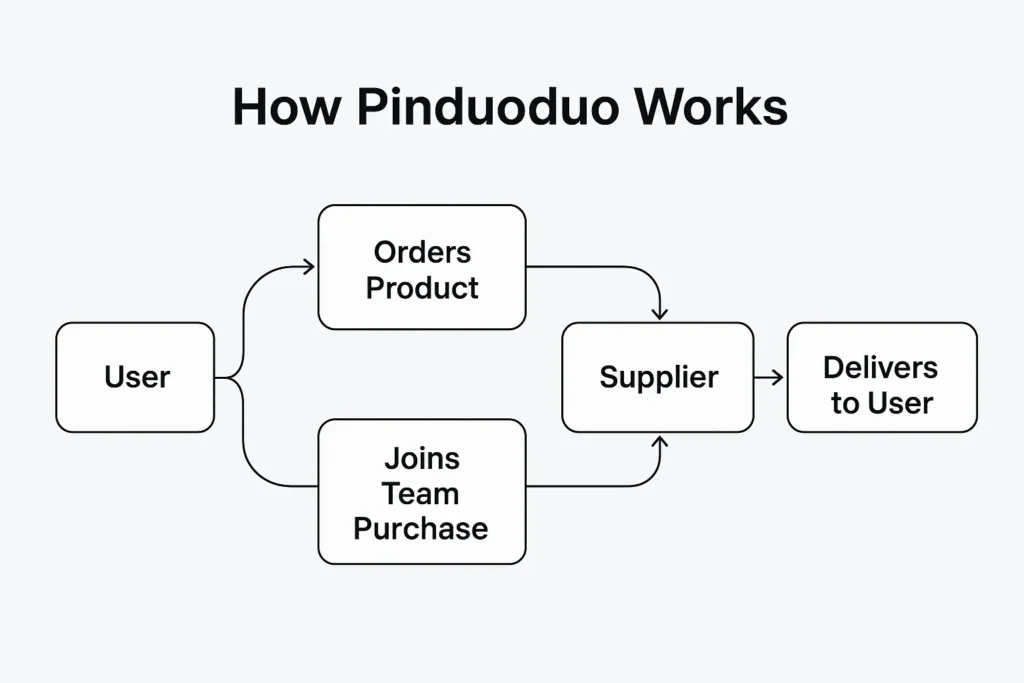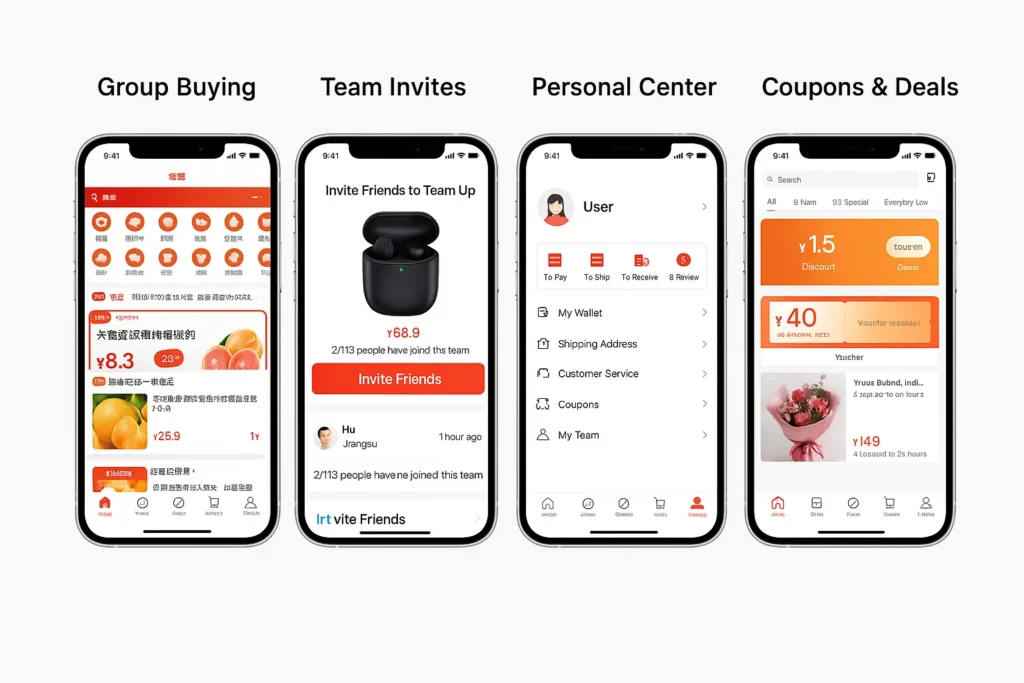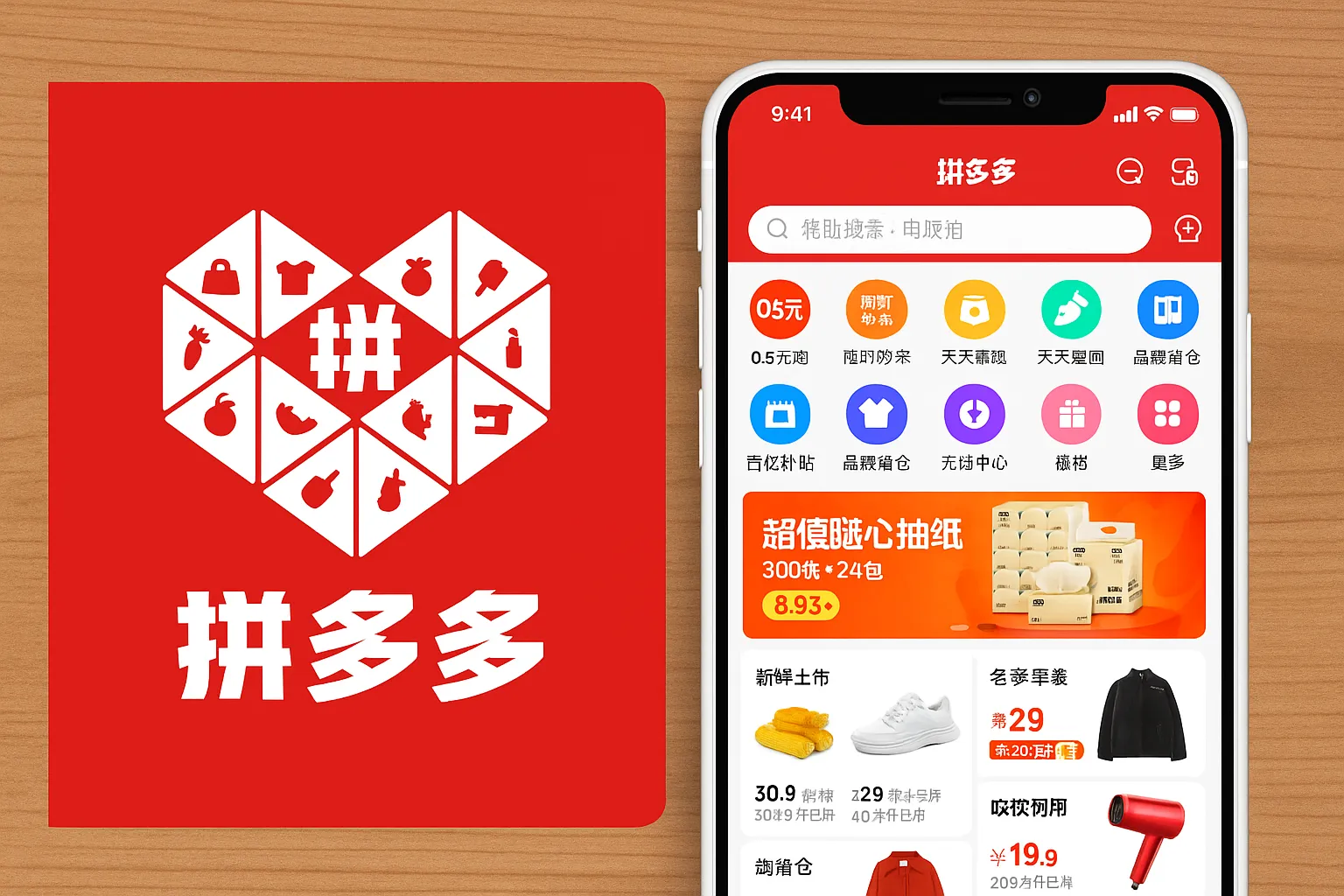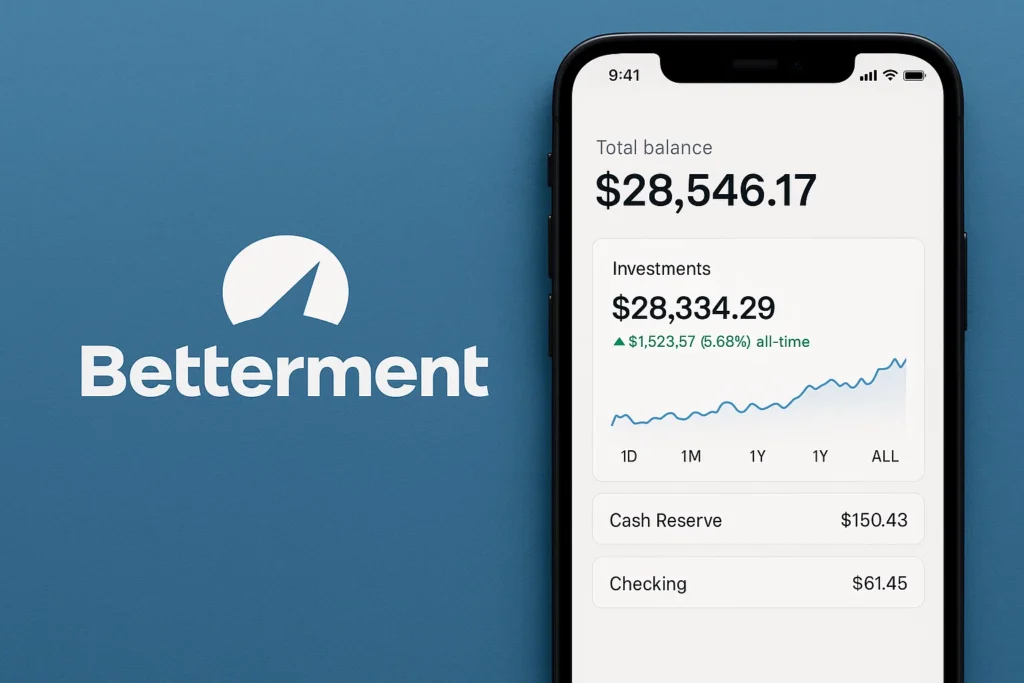Imagine getting the best deals online — but only if you and your friends join in. That’s the magic of Pinduoduo, China’s social commerce sensation, where shopping becomes a team sport. Instead of buying alone, users team up to unlock discounts that are impossible to get solo.
Founded in 2015 by Colin Huang, Pinduoduo began as a small social e-commerce startup with one big idea: combine group buying with gamified shopping. By leveraging WeChat’s social ecosystem, it rapidly attracted millions of users eager to save money through collective purchasing.
Fast-forward to 2025, and Pinduoduo — now under its parent company PDD Holdings — serves over 900 million active buyers, challenging e-commerce giants like Alibaba and JD.com. It has also expanded globally through Temu, its international counterpart, redefining how social-driven e-commerce works worldwide.
What is Pinduoduo? The Simple Explanation
Pinduoduo is a social e-commerce platform from China that lets users team up with friends, family, or even strangers to buy products at deep discounts. Instead of traditional one-to-one shopping, Pinduoduo’s model thrives on “team buying”, where collective purchasing unlocks lower prices for everyone.
The Core Problem It Solves
Before Pinduoduo, online shopping in China was dominated by major players like Taobao and JD.com, offering convenience but little social interaction. Pinduoduo solved the problem of high product costs and low engagement by introducing a gamified, social shopping experience that rewards group participation.
Target Users and Use Cases
Pinduoduo primarily targets:
- Price-sensitive shoppers in smaller Chinese cities (Tier 2–4)
- Social media users who enjoy sharing deals
- Vendors/farmers/manufacturers looking for direct-to-consumer channels
Use cases range from buying daily essentials and electronics to fresh produce — all through social sharing.
Current Market Position (2025)
- Active Buyers: 900+ million
- Gross Merchandise Value (GMV): Over $500 billion (2024 estimate)
- Parent Company: PDD Holdings (also owns Temu, its global platform)
- Mobile Market Share: One of China’s top 3 shopping apps, surpassing JD in user base.
Its popularity continues to grow globally through Temu, now active in over 50 countries.
Read more: Complete Guide to Starting an E-commerce App Business
Why It Became Successful
Pinduoduo blended social media, entertainment, and shopping into one app. The result? An addictive, gamified experience where users save money by inviting others. This blend of community-driven buying and viral engagement reshaped how China shops online.
How Does Pinduoduo Work? Step-by-Step Breakdown
Pinduoduo’s power lies in its interactive shopping model, where users are motivated to buy through group participation and game-like experiences rather than just price tags. Let’s break it down clearly:
For Users
1. Account Creation Process
- Users sign up easily using their WeChat or mobile number.
- Once logged in, they can browse categories like groceries, fashion, electronics, and household goods.
2. Main Features Walkthrough
- Team Purchase (拼单 / Pin Dan): Invite friends to join a group buy to unlock discounts.
- Solo Buy: Purchase instantly at a slightly higher price.
- Mini-Games: Earn coupons by playing small games like “Fruit Farm” or “Cash Draw.”
- Flash Deals & Coupons: Timed offers with social sharing boosts visibility.
- Social Sharing: Share deals via WeChat Moments or chat to recruit more buyers.
3. Typical User Journey Example
- A user finds a T-shirt priced at $10 (solo).
- They notice it drops to $7 if two people join.
- The user shares the link on WeChat; a friend joins.
- Both get the discounted price and a small reward coupon for future purchases.
4. Key Functionalities Explained
- Personalized recommendations driven by AI.
- Gamified engagement (daily check-ins, coupons, spins).
- Community trust via verified seller badges.
- Free shipping thresholds and guaranteed returns.
For Merchants & Service Providers
1. Onboarding Process
- Merchants register via Pinduoduo’s Seller Center.
- They verify business licenses and list products directly or through Pinduoduo’s fulfillment partners.
2. How They Operate
- Sellers can choose between direct selling or group deal participation.
- They set discounts based on the minimum group size needed for activation.
- Orders are processed in bulk once group deals are fulfilled.
3. Earnings & Commission
- Pinduoduo charges 0.6%–1.5% commission per transaction, depending on category.
- Advertising tools (CPC and banner placements) provide extra revenue for the platform.
- Merchants gain higher volume sales with slightly lower profit margins — offset by scale.
Technical Overview (Simplified)
- Frontend: Built using Flutter and React Native for cross-platform performance.
- Backend: Relies on microservices architecture powered by Java, Go, and Node.js.
Data & AI: Uses real-time recommendation engines with AI/ML models to personalize deals. - Payments: Integrated with WeChat Pay and Alipay for seamless checkout.
- Cloud Infrastructure: Runs on Alibaba Cloud with global CDN for Temu operations.

Pinduoduo’s Business Model Explained
Pinduoduo’s growth is powered by one of the most innovative e-commerce business models in the world — blending group buying, social sharing, and gamification into a single, highly scalable ecosystem.
How Pinduoduo Makes Money
Pinduoduo operates primarily on a low-margin, high-volume model. Instead of charging high commissions like traditional marketplaces, it focuses on mass transactions and advertising revenue.
Here’s how it earns:
- Commissions from Sales — Typically 0.6%–1.5% per transaction.
- Advertising Revenue — Sellers pay for featured placement and PPC ads on search results or category pages.
- Value-Added Services — Data analytics, fulfillment, logistics support, and cross-border sales.
- Pinduoduo DuoDuo Grocery (多多买菜) — A community group-buying service generating revenue through daily essentials.
- Temu (International Arm) — Expansion into global markets (USA, Europe) with similar gamified commerce, earning via commissions and ad placements.
- Financial Services Integration — Microloans and supply-chain financing for merchants.
Pricing Structure (2025 Snapshot)
| Category | Typical Price Range | Group Discount % | Commission Rate |
| Groceries & Produce | $1–$20 | 10–30% | 0.6% |
| Fashion & Accessories | $5–$50 | 15–35% | 1.0% |
| Electronics | $20–$300 | 8–20% | 1.2% |
| Home & Kitchen | $5–$100 | 10–25% | 1.0% |
| Cross-Border (Temu) | $3–$200 | 5–15% | 1.5% |
Market Size & Growth Stats
- Global GMV (2024): $500+ billion
- Revenue (2024): $34 billion (PDD Holdings)
- Annual Growth Rate: 21% year-over-year
- International Expansion: Operating in 50+ countries via Temu
- Merchant Base: 12+ million sellers (domestic and cross-border)
Profit Margins Insights
Although Pinduoduo keeps low per-sale margins, it compensates through scale, engagement, and ad revenue. Its average operating profit margin (2025) stands around 24%, driven largely by data monetization and international growth.
| Revenue Stream | Description | Share of Total Revenue (2025 est.) |
| Advertising | Paid promotions, keyword ads, banners | 48% |
| Commissions | Percentage from each transaction | 32% |
| Logistics & Value-Added Services | Fulfillment, data tools, partner fees | 10% |
| Cross-Border & Temu | International sales | 8% |
| Others (Finance, Rewards) | Merchant loans, digital wallets | 2% |
Key Features That Make Pinduoduo Successful
Pinduoduo stands out not just for its pricing model — but for how social, interactive, and addictive it makes online shopping. Its design philosophy revolves around turning shopping into a game, a conversation, and a reward system — all at once.
Top 10 Features That Made Pinduoduo a Phenomenon
1. Group Buying (Team Purchase / 拼单)
- Why it matters: Encourages social sharing and viral growth.
- Benefit: Users save more by teaming up with others.
- Innovation: Dynamic pricing engine automatically adjusts discounts based on group size.
2. Gamified Shopping
- Users earn coins, coupons, or cashback by playing mini-games like Duo Duo Orchard.
- Result: Increased app stickiness and average daily usage time (≈30+ minutes per user).
3. Social Sharing via WeChat Integration
- Seamlessly connects with WeChat Moments and group chats.
- Effect: 70%+ of traffic originates from social referrals, not ads.
4. Personalized Recommendations
- AI-powered feed shows trending deals and friend activity, similar to TikTok’s “For You” page.
- Learns preferences through browsing, sharing, and purchase behavior.
5. Daily Flash Sales & Lucky Draws
- Creates urgency through countdown deals and “spin-to-win” offers.
- Drives impulse buying and session frequency.
6. Live Streaming Commerce
- Merchants host real-time product demos and interact with users.
- Boosts conversion rates by up to 60% compared to static listings.
7. Duo Duo Grocery (Community Group Buying)
- Users in the same neighborhood form groups to bulk-order daily items.
- Localized logistics model reduces delivery costs and improves margins.
8. Merchant Tools Dashboard
- Provides sales analytics, product performance insights, and ad campaign tracking for sellers.
- Encourages smarter discount and inventory strategies.
9. Buyer Protection & Refund System
- Simplified “one-click refund” feature and transparent seller ratings build trust.
- Essential for retaining users in competitive e-commerce markets.
10. Temu Integration (Global Expansion)
- Pinduoduo’s international arm brings the same gamified model to Western markets.
- Cross-border sellers access global buyers through unified backend systems.
Recent 2025 Updates
- AI-powered deal curation: Pinduoduo’s algorithms now highlight “Smart Value Picks” based on community ratings.
- AR-based try-ons: Early pilots for virtual product previews.
- Sustainability badges: Products now carry eco-friendly certifications.
AI/ML Integrations
- Dynamic pricing optimization for real-time discount adjustments.
- Predictive logistics to forecast demand by region.
- Smart fraud detection for fake reviews and counterfeit listings.
What Sets Pinduoduo Apart
Unlike typical e-commerce apps, Pinduoduo combines social virality + gamified engagement + community commerce, turning customers into brand promoters and active participants, not just buyers.

The Technology Behind Pinduoduo
While Pinduoduo feels like a simple, fun shopping app on the surface, it’s actually powered by one of China’s most sophisticated, AI-driven e-commerce ecosystems underneath. Its success is deeply tied to its scalable technology architecture, data intelligence, and real-time user personalization.
Tech Stack Overview (Simplified)
| Layer | Technology Used | Purpose |
| Frontend | Flutter, React Native | Unified UI for Android & iOS, responsive app performance |
| Backend | Java, GoLang, Node.js (microservices) | High-speed concurrent transaction processing |
| Database | MySQL, Redis, MongoDB | Handles millions of concurrent users & cached data |
| Cloud Infrastructure | Alibaba Cloud, CDN Edge Nodes | Low latency and high availability across China & global markets |
| AI/ML Tools | TensorFlow, PyTorch | Product recommendations, demand forecasting, and fraud detection |
| Payment Integration | WeChat Pay, Alipay | Secure, fast transactions for users and merchants |
| Analytics & Monitoring | Hadoop, Kafka | Real-time analytics, data pipelines, event streaming |
Real-Time Features
- Dynamic Pricing Engine: Constantly adjusts prices based on demand, group size, and inventory.
- Instant Deal Notifications: Push alerts driven by event-based triggers using Kafka Streams.
- Social Graph Mapping: Tracks shared links, referral chains, and engagement loops to optimize virality.
- AI Chatbots: Handle millions of customer service queries simultaneously in-app.
Data Handling and Privacy
- Implements end-to-end encryption for transactions and chat data.
- Anonymized user IDs protect privacy while enabling behavioral analytics.
- AI fraud detection models monitor fake promotions or malicious sellers.
- Compliance with China’s Data Security Law (DSL) and Personal Information Protection Law (PIPL) ensures regulatory adherence.
Scalability Approach
- Uses microservice clusters and load balancers to manage massive traffic spikes during flash sales.
- Containerized deployment (Docker + Kubernetes) ensures elasticity during campaign surges.
- Supports over 50 million concurrent transactions per minute during peak events like “Double 11” (Singles’ Day).
Mobile App vs Web Platform
- Mobile-first design with 95% of traffic from smartphones.
- Web app primarily supports Temu’s international operations for cross-border shoppers.
- Both platforms share a common backend and recommendation algorithms for data consistency.
API Integrations
- Merchant APIs for inventory sync, product upload, and price updates.
- Partner APIs for logistics, warehouse management, and data analytics.
- Financial APIs for payments, refunds, and loan services.
Why This Tech Matters for Business
Pinduoduo’s tech foundation enables:
- Fast scalability to millions of daily users
- AI-driven personalization that keeps shoppers hooked
- Low operational costs through automation
- High reliability — 99.98% uptime during major sale events
Pinduoduo’s Impact & Market Opportunity
Pinduoduo didn’t just create a new e-commerce model — it redefined the entire retail experience in China. By merging social interaction, entertainment, and savings, it sparked a global movement toward social commerce, influencing platforms worldwide.
Industry Disruption
Before Pinduoduo, e-commerce was largely transactional. Pinduoduo transformed it into a participatory, gamified ecosystem, creating the concept of “team shopping for fun and profit.”
This shift disrupted traditional giants like Alibaba and JD.com, forcing them to adopt similar community-based shopping models.
Market Statistics & Growth
- Active Buyers (2025): 900+ million
- Annual Orders Processed: 19+ billion
- Average Daily Active Users (DAU): 300+ million
- App Retention Rate: 82% (one of the highest in China’s e-commerce sector)
- Global Reach via Temu: Present in 50+ countries, including the U.S., U.K., Canada, and Australia
User Demographics & Behavior
- 70% of users are aged 18–35, reflecting a young, tech-savvy audience.
- Majority from lower-tier cities in China, attracted by affordable prices.
- Heavy engagement through WeChat sharing and mini-games.
- Average user spends 20–30 minutes per day inside the app.
Geographic Presence
- Domestic: Extensive coverage across mainland China, with local logistics networks and community hubs.
- International: Through Temu, Pinduoduo entered North America, Europe, and parts of Asia-Pacific.
- Localized Warehousing: Ensures fast delivery and low costs across regions.
Future Projections (2025–2030)
- Estimated Market Cap by 2030: $300+ billion
- Projected Annual GMV Growth: 18–20% CAGR
- Expansion Focus: AI-driven personalization, supply chain automation, and sustainable commerce
- Emerging Trend: Rise of “Shoppertainment” — blending video, gaming, and live shopping experiences.
Opportunities for Entrepreneurs
Pinduoduo’s explosive success proves that social commerce is the future. Entrepreneurs now explore similar business models in:
- Localized grocery delivery apps
- Community-based retail platforms
- Niche e-commerce clones (fashion, electronics, home décor)
- International social shopping platforms like Temu
These ventures thrive when built on viral growth mechanics, AI personalization, and group incentives — exactly what Pinduoduo mastered.
Building Your Own Pinduoduo-Like Platform
The success of Pinduoduo has inspired hundreds of entrepreneurs to create social-commerce platforms around the world. Its combination of gamified engagement, team buying, and viral referral mechanics offers a blueprint for any startup aiming to build a loyal user community and scale fast.
Why Businesses Want Pinduoduo-Style Clones
- Proven market traction: Group-buying and social shopping models are projected to reach $1.5 trillion globally by 2027.
- High user retention: The game-like interface keeps users returning daily.
- Low CAC (Customer Acquisition Cost): Built-in referral loops turn customers into marketers.
- Scalable model: Works across categories — grocery, fashion, beauty, electronics, or local community deals.
Key Considerations for Development
- Social Integration: Must connect with popular chat or social apps (like WeChat, WhatsApp, or Telegram).
- Gamification Engine: Points, spins, coupons, and reward loops drive engagement.
- AI-Driven Pricing & Recommendation: Personalized offers increase conversions.
- Scalable Cloud Infrastructure: Should support millions of concurrent sessions.
- Payment Gateways: Seamless checkout via PayPal, Stripe, or regional e-wallets.
- Data Privacy & Security: Compliance with GDPR, CCPA, and local data laws.
Time and Cost Factors
With Miracuves, you don’t have to start from scratch.
A ready-to-launch Pinduoduo Clone App can go live in 7–14 days, starting around $3,299 USD.
Full-stack customization (UI, admin, AI modules, gamification, and multi-currency setup) can take 3–5 weeks, depending on your requirements.
Essential Features to Include
- Team / Group buying system
- Merchant dashboard with analytics
- AI-based recommendation feed
- Mini-games & loyalty wallet
- Live-stream shopping
- Multi-vendor marketplace
- In-app wallet & rewards
- Advanced admin panel for analytics & fraud control
Conclusion
Pinduoduo’s rise from a 2015 startup to a global e-commerce powerhouse is nothing short of revolutionary. By blending group buying, gamification, and social sharing, it redefined how people shop online — turning every transaction into a social experience.
In 2025, its influence continues to expand worldwide through Temu, inspiring a new generation of community-driven, AI-powered commerce platforms. What makes Pinduoduo so remarkable is that it didn’t just lower prices — it built a digital ecosystem where engagement creates value, for both users and sellers alike.
For entrepreneurs, this model proves that the future of e-commerce isn’t just about convenience — it’s about connection, collaboration, and community.
Ready to build your own Pinduoduo-like social commerce app?
With Miracuves, you can launch in just 3-6 days using our proven, fully customizable clone solutions. Start today — Contact Us for a free consultation and detailed demo.
FAQs
Q:1 How does Pinduoduo make money?
Pinduoduo earns revenue through sales commissions (0.6–1.5%), advertising fees, and value-added services such as logistics, merchant loans, and its international arm, Temu. Nearly half its income comes from advertising.
Q:2 Is Pinduoduo available in my country?
Pinduoduo itself primarily operates in China, but its global version — Temu — is available in over 50 countries, including the U.S., Canada, U.K., Australia, and Europe.
Q:3 How much does Pinduoduo charge users?
Pinduoduo does not charge users any subscription or listing fees. Buyers pay only for the products, often at discounted “team-buy” prices that drop 10–35% below standard retail.
Q:4 What is the commission for service providers or sellers?
Sellers pay a 0.6%–1.5% transaction fee, depending on product category. Additional paid promotions can increase visibility through keyword ads and featured listings.
Q:5 How does Pinduoduo ensure safety?
The platform uses AI-driven fraud detection, verified merchant programs, and a “one-click refund” system. All payments are processed via WeChat Pay or Alipay, ensuring secure transactions.
Q:6 Can I build something similar to Pinduoduo?
Yes. With the help of Miracuves, you can launch a Pinduoduo Clone App in 3-6 days — complete with team buying, gamification, merchant dashboards, and scalable cloud infrastructure.
Q:7 What makes Pinduoduo different from competitors?
Pinduoduo stands apart due to its social buying mechanics, gamified features, and viral WeChat integration, making shopping more social, engaging, and affordable than traditional e-commerce apps.
Q:8 How many users does Pinduoduo have?
As of 2025, Pinduoduo boasts over 900 million active buyers and processes more than 19 billion annual orders, making it one of the world’s largest e-commerce platforms.
Q:9 What technology does Pinduoduo use?
It uses Flutter and React Native for the frontend, Java/Go for backend microservices, AI models (TensorFlow & PyTorch) for recommendations, and Alibaba Cloud for scalable hosting.
Q:10 How can I create an app like Pinduoduo?
You can build your own social-commerce app using the Miracuves Pinduoduo Clone — a pre-built, customizable solution that can go live in under two weeks
Related Articles:







